2.5″ SATA SSDs are much faster than 2.5″ HDDs. They also take up less space and make less noise. For all these reasons, the 2.5″ SATA SSD is the ideal upgrade for a desktop or laptop PC. And if you already have an SSD installed on your machine, having more storage wouldn't hurt. Read this guide to find what you need.
Here is our commitment, to make sure that we provide the best user experience and content quality:
You can support us by using our links to make your purchases (at no extra cost to you)! This sometimes earns us a commission which allows us to remain independent. More about us
Our selection
"The SanDisk Ultra 3D promises high performance and an attractive price. Plus, it's backwards compatible. No wonder it is rated so highly by buyers on…"
"The 500GB version of the WD Blue 3D offers decent performance for a very affordable price. If you're looking for a great deal, this 2.5″…"
"The Samsung 860 Evo offers a clear improvement to its predecessor. It boasts faster speeds and greater endurance, while keeping an attractive price."
"Offered at a bargain price, the Crucial MX500 500GB manages fast read and write speeds. It is perfect for upgrading a desktop or laptop PC."
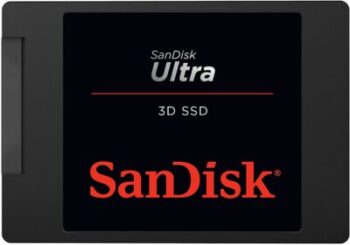
The SanDisk Ultra 3D promises high performance and an attractive price. Plus, it's backwards compatible. No wonder it is rated so highly by buyers on Amazon.
See priceThe SanDisk Ultra 3D has a 7 mm chassis. It benefits from a simplistic, but nice finish. On the downside, this next-generation SSD doesn't come with a bay converter to fit it into 3.5″ slots. But that won't be a huge concern, as the SSD's 2.5″ form factor fits perfectly in the computer without having to attach it to the chassis.
Inside, the new SanDisk Ultra 3D uses the new Marvell SS889175 controller, which is compatible with both SSD and SATA standards. The controller supports SATA III (6 Gbps). In addition, it is backwards compatible. As for the flash memory, the SanDisk Ultra 3D uses 19 nm NAND eX2 ABL MLC. This is a multi-layer cellular memory, popular in consumer SSDs.
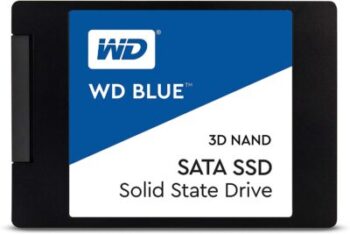
The 500GB version of the WD Blue 3D offers decent performance for a very affordable price. If you're looking for a great deal, this 2.5″ SATA SSD will interest you.
45 £ on DartyLike most SATA SSDs, the WD Blue 3D has a 2.5″ form factor. It works on any operating system. This SD 2.5″ SATA still uses the Marvell 88SS1074, a 4-channel controller with low density parity check (LDPC) for error correction and can work with MLC, TLC and 3D NAND TLC flash.
There is a realistic speed limit for SATA drives, and most modern SSDs approach or run into it at around 560MB/s. What's interesting about this 2.5″ SATA SSD drive from WD is that it not only reaches speeds of 560 MB/s read and 530 MB/s write, but it slightly exceeds those numbers in real-world conditions. For example, with CrystalDiskMark 6.0.0, we measured 563.7 MB/s read and 536.8 MB/s write!
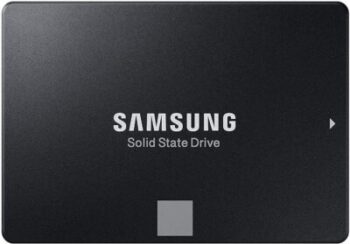
The Samsung 860 Evo offers a clear improvement to its predecessor. It boasts faster speeds and greater endurance, while keeping an attractive price.
See the priceThe specifications allow this M.2 SATA version of the Samsung 860 Evo series to reach speeds of 560 MB/s sequential read and 520 MB/s write. Numerous tests have shown significant performance improvements over the previous model. For example, there is an increase from 5 to 20 MB/s in for sequential read and write. The 2.5″ version of the Samsung 860 Evo also achieves much higher random read and write speeds, 60 to 70 MB/s faster!
Samsung has also improved the endurance of the 860 Evo. This is measurable via the Total Bytes Written application, which gives an idea of the lifespan of the Korean brand's drives. While Samsung pinned its last generation 850 Evo with a TBW of 300, the 860 Evo does better, with a whopping 1,200 TBW, or 4 times more enduring than its predecessor. Who says better?
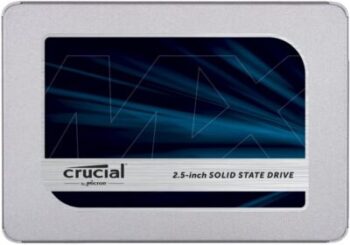
Offered at a bargain price, the Crucial MX500 500GB manages fast read and write speeds. It is perfect for upgrading a desktop or laptop PC.
See priceThe MX500 is the first Crucial drive based on Micron's 64-layer 3D TLC NAND. It also represents the second generation of the Crucial MX consumer series, which uses TLC NAND instead of MLC NAND. In addition, the MX500 breaks with previous MX generations by using Silicon Motion's SM2258 controller instead of a Marvell controller. However, all the usual MX series features remain present.
This 500GB MX500 from Crucial is clearly slower than the 1TB model. And at first glance, its performance doesn't compete with the other SSDs presented in this comparison. However, you will be very hard pressed to find a 2.5″ SATA SSD with 500GB storage capacity that performs as well.
Any specific needs?
The best 2.5″ SATA SSD in 2021
The best entry-level 2.5" SATA SSD
The best high-end 2.5″ SATA internal SSD
A remarkable 500GB 2.5″ SATA SSD
Your guide :
Rate this buying guide :By rating this buying guide, you are helping us to reward our best writers. Thank you!
| TOP OF THE TOP | CHEAP | TOP OF THE LINE | EXCELLENT | |

In accordance with our commitment, this buying guide does not contain any sponsored products. |
 9/10 |
 7/10 |
 8/10 |
 8/10 |
| OUR SELECTION |
SanDisk Ultra 3D
|
WD Blue 3D 2,5" SATA
|
SSD 2,5″ SATA - Samsung 860 EVO SATA
|
Crucial MX500 500 GB
|
|
The SanDisk Ultra 3D promises high performance and an attractive price. Plus, it's backwards compatible. No wonder it is rated so highly by buyers on Amazon.
|
The 500GB version of the WD Blue 3D offers decent performance for a very affordable price. If you're looking for a great deal, this 2.5″ SATA SSD will interest you.
|
The Samsung 860 Evo offers a clear improvement to its predecessor. It boasts faster speeds and greater endurance, while keeping an attractive price.
|
Offered at a bargain price, the Crucial MX500 500GB manages fast read and write speeds. It is perfect for upgrading a desktop or laptop PC.
|
|
|
Storage capacity
|
2 TB
|
500 GB
|
2 TB
|
500 GB
|
|
Read and write speed
|
560 MB/s and 530 MB/s
|
560 MB/s and 530M/s
|
520 MB/s and 500 MB/s
|
560 MB/s and 510 MB/s
|
|
Endurance
|
500 TBW
|
200 TBW
|
1,200 TBW
|
700 TBW
|
|
Dimensions (L x W x D)
|
10.1 x 0.7 x 7 cm
|
10.2 x 0.8 x 7.1 cm
|
10 x 0.7 x 7 cm
|
10.3 x 0.7 x 7 cm
|
|
Weight
|
50 g
|
50 g
|
62 g
|
32.2 g
|
Help us improve this table:
Report an error, request the addition of a feature to the table, or suggest another product. Thank you for your kindness!
We spend thousands of hours each year studying the major specialized websites, analyzing products of hundreds of brands and reading user feedback to advise you on the best products.
We are a product review company with a single mission: to simplify your buying decisions. Our research and testing helps millions of people every year find the best products for their personal needs and budget.
To support us you can: use our links to make your purchases (which often earns us a small commission), share our articles on social networks, or recommend our site on your blog. Thanks in advance for your support!
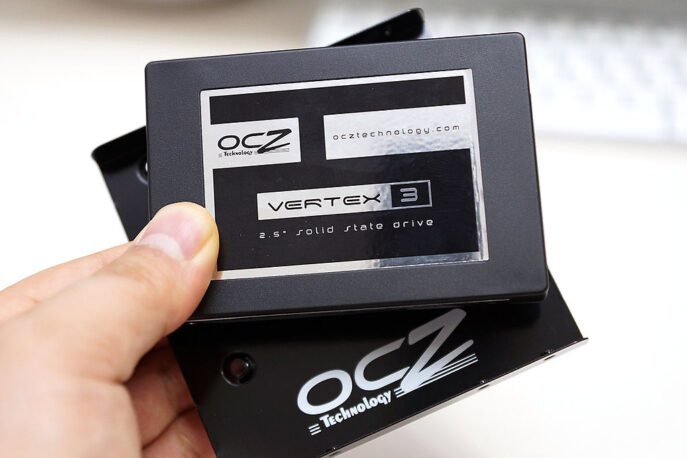
The best 2.5″ SATA SSDs available on the market today have a read speed of at least 500MB/s and a write speed of at least 300MB/s. You must have a SATA III (6.0 Gbps) controller on the motherboard to support such speeds. Otherwise, you won't get the full benefit. On a SATA II type controller, you get a read speed of about 250 MB/s and a write speed of about 150 MB/s. Generally speaking, if your computer dates from before 2011, opt for a SATA II SSD. Otherwise, the SATA III SSD is recommended.
The consumer 2.5″ SATA SSDs come in 2 types based on the NAND flash memory used in its design: MLC (Multi-Level Cell) and TLC (Triple Level Cell). The main difference between the two is that TLC memory can store more information on each cell, giving a production cost efficiency advantage and therefore a cheaper price. But this does not happen without some disadvantages, which reduce endurance and result in a higher error rate. So if you're a hardcore gamer and want an SSD that will last a long time and can handle the toughest conditions without a drop in performance, go for MLC.
If your system supports the SATA III interface, go for an SSD that supports the same interface to get the highest possible transfer speed. The important point here is that 2.5″ SATA III SSDs are backward compatible and work with any version of the SATA controller. So, if you are planning to upgrade your computer or its motherboard that includes a SATA III controller, but still want to enjoy the high speed of the SSD on your current system, go for a SATA III SSD. Otherwise, if that upgrade is going to happen later, go for a SATA II SSD, as it's cheaper.
ECC memory is the hallmark of SSD reliability. As the name implies, error-correcting code (ECC) memory helps your SSD detect and correct the most common data corruptions, preventing potential instability and removing unusable data from your drive.
As with any computer hardware, the reputation of the SSD manufacturer impacts its quality. Currently, the most reliable SSDs come from Intel, Samsung, OCZ, Corsair, Crucial, SanDisk and a few others. Don't hesitate to read consumer reviews about the SSD you want to buy.
Laptops
You have room for one, two or four 2.5″ SATA SSDs, two M.2 drives or one or two mSATA drives. Also be aware that laptops with M.2 slots may have one or two that are SATA or NVMe slots. To add new SSDs, you need to know what type of slots your computer has.
Desktop computers
Most have been limited to SATA connections until recently. Some motherboards now support NVMe slots and PCIe cards that can hold up to four NVMe SSDs. While the switch from SATA to NVMe doesn't make significant changes to the speed of many applications, games, graphics programs, data mining and other specialized applications can benefit from performance gains of up to 6x.
Computer Servers
The new models are now designed with 2.5″ SSDs. They can support up to 20 2.5″ SSDs or up to 36 M.2 SSDs. Upgrading older systems with new SSDs requires following the same approach as for laptops or PCs: determine the types of interfaces that existing drives use and replace them with SSDs that use the same interface.
In 2000, SATA was introduced to replace the Parallel ATA standard. SATA offered faster connections, which meant significantly improved performance over its predecessor. SATA III was deployed eight years later with a maximum transfer rate of up to 600 MB/s.
SATA drives require a SATA power cable as well as a separate SATA data cable, unless you are using an M.2 SATA SSD. Common SATA devices include 2.5″, 3.5″ SSDs and 5.25″ Blu-ray drives.
Once a drive is connected to the computer system via SATA III, the job is only half done. For the drive to actually communicate with the system, it needs a host controller interface, namely AHCI. The SATA SSD is now in its fourth generation. The longevity of fourth-generation SATA SSDs is much longer than that of first-generation SSDs, which only have a lifespan of a year or two.
NVMe (Non-Volatile Memory Express) is an open source hardware interface that was developed to allow modern SSDs to operate at the optimal read and write speeds that their flash memory is capable of.
It allows flash memory to operate as an SSD directly through the PCIe interface rather than through SATA and be limited by the slower SATA speeds. In other words, it's a description of the bus that the SSD uses to communicate with the PC, not a new type of flash memory. It's also not tied to the form factor, which is why NVMe drives can be available in both M.2 and PCIe card form factors.
Using the new NVMe standard, an SSD can support data rates of up to 3,500 MB/s. Input/output operations per second (IOps) are also up to ten times higher, from about 50,000 IOps with a SATA drive to 500,000 IOps with an NVMe drive.
While the NVMe interface is fantastic, there's no reason to abandon SATA SSDs just yet. Despite the limitations of SATA III, it's still a good choice for secondary storage.
Anyone putting together a new PC, for example, would do well to use an M.2 NVMe drive for their boot drive and primary storage. They could then add a cheaper drive like a 2.5″ SATA SSD with more capacity as secondary storage.
Update the SSD firmware
To ensure that your 2.5″ SATA SSD is working optimally, you should always keep an eye out for firmware updates. Usually, the installation of these is not automated. Each SSD manufacturer has its own method for SSD firmware upgrades, so you'll need to go to your SSD manufacturers' official websites and follow the steps listed. You can also use software like CrystalDiskInfo, which displays detailed information about your SSD, including the firmware version.
Disable indexing in Windows
When
your 2.5″ SATA SSD is connected to your PC, always disable indexing. Much of your SSD's speed is consumed in indexing files for Windows search. This can be useful if you store everything you have on your SSD, but it could annoy you if you experience slowdowns due to the periodic indexing process that occurs every time you add new data to the drive.
Disable Prefetch and Superfetch on Windows
Windows
sometimes places information in your physical memory and virtual memory belonging to programs that you don't currently use but use very often. This is called "Prefetch" and "Superfetch". If you have to manage virtual memory on your SSD, you'd better get rid of these two features. You can find them on your registry editor under "HKEY_LOCAL_MACHINE Current ControlSet Control Session Manager Memory Management PrefetchParameters" and as two values: "EnablePrefetcher" and "EnableSuperfetch". Set both values to zero to disable.
Configure write caching
On
many 2.5″ SATA SSDs, user-level write caching can have a detrimental effect on the drive. To understand this, you'll need to disable the option in Windows and see how the drive performs afterwards. If your drive performs worse, turn it back on.
Set the power option to "High Performance".
This
should be a no-brainer. When your SSD turns on and off all the time, you'll notice a slight lag every time you use your computer after it's been idle for a while. To change your power options, go to your control panel, click on "System and Security" and then "Power Options". Select "High Performance" from the list. You may need to click on "Other Additional Options" to find it. On a laptop, you can click on the battery icon in your notification area and select "High Performance" from there.
The best 2.5″ SATA SSD depends on your needs and budget. Read our buying guide for the best products out there today.
Disconnect all other hard drives or SSDs. Start the Windows 7 installation disk. Choose "Repair", then "Advanced", then "Command Prompt". Type: "diskpart" without quotes and press Enter. You will see a command called "diskpart". Type the following commands and press Enter after each one.
, restart the computer on the Windows 7 installation disk.
You can, but you must first disable the drive security on the original computer. Then you can re-enable it on the new computer.
The technology used in SSDs is more advanced and newer, while HDDs have been around for over half a century now. For almost a decade, the price gap between SSDs and HDDs has been narrowing. But an SSD is still more expensive than an HDD and it will remain so.
The hard drive is made up of magnetic platters that rotate to make it work. This technology has been used since the mid-1950s. Because of the moving parts, hard drives sometimes fail due to mechanical problems, heat, shock, cold and vibration. In the case of the SSD, there are no moving parts, but memory chips; the same ones found in USB flash drives and other compact flash storage devices available on the market. They are less prone to damage from shocks and the vagaries of nature.
Every month we help more than 1 000 000 people buy better and smarter.
Copyright © 2022 - Made with ♥ by buyingbetter.co.uk
Your reviews and buying guides 0% advertising, 100% independent!